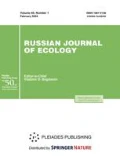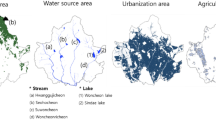Abstract
We tried to model habitat suitability of two prey and predator species including wild sheep (Ovis orientalis) and wolf (Canis lupus) in Varjin protected area located in northern east of Tehran using a presence only method, maximum entropy (MaxEnt). Totally 11 environmental variables were measured in the species presence points which can be classified in three groups including topographical, vegetation and distal variables. Resulted maps indicated that habitat variables such as slope (ranging from 35 to 40 percent) and elevation (lower than 1700 meters above sea level) are both institute those factors which mostly affect studied prey and predator habitat use. Our results regarding prey and predator geographical range of used habitat indicated that wolves cover most area than wild sheep which show more dispersed habitat resources for the prey species. ENMTools test revealed that wolf’s niche breadth is more than twice as much as wild sheep’s. Wild sheep in Varjin protected area has a relatively narrow geographical extent and shows a tendency to marginal habitats while wolves cover obviously more areas which denotes its high mobility and low dependency to specific habitats.
Similar content being viewed by others
References
Andren, H., Effects of habitat fragmentation on birds and mammals in landscapes with different proportions of suitable habitat: A review, Oikos, 1994, pp. 355–366.
Fahrig, L., Relative effects of habitat loss and fragmentation on population extinction, J. Wildl. Manag., 1997, pp. 603–610.
Svancara, L.K., Scott, M., Groves, C.R., Noss, R.F., and Pressey, R.L., Policy-driven versus evidence-based conservation: A review of political targets and biological needs, BioScience, 2005, vol. 55, pp. 989–995.
Kearney, M. and Porter, W.P., Mapping the fundamental niche: Physiology, climate, and the distribution of a nocturnal lizard, Ecology, 2004, vol. 85, pp. 3119–3131.
Price, T.D. and Kirkpatrick, M., Evolutionarily stable range limits set by interspecific competition, Proc. R. Soc. London, Ser. B, 2009, vol. 276 (1661), pp. 1429–1434. doi 10.1098/rspb.2008.1199
Arsenault, R. and Owen-Smith, N., Facilitation versus competition in grazing herbivore assemblages, Oikos, 2002, vol. 97, pp. 313–318.
Zollner, P.A. and Lima, S.L., Search strategies for landscape-level interpatch movements, Ecology, 1999, vol. 80, pp. 1019–1030.
Williams, J.N., Seo, C., Thorne, J., Nelson, J.K., Erwin, S., O’Brien, J.M., et al., Using species distribution models to predict new occurrences for rare plants, Divers. Distributions, 2009, vol. 15, pp. 565–576.
Forrest, J.L., Wikramanayake, E., Shrestha, R., Areendran, G., Gyeltshen, K., Maheshwari, A., et al., Conservation and climate change: Assessing the vulnerability of snow leopard habitat to treeline shift in the Himalaya, Biol. Conserv., 2012, vol. 150, pp. 129–135.
Aryal, A., Brunton, D., Ji, W., and Raubenheimer, D., Blue sheep in the Annapurna Conservation Area, Nepal: Habitat use, population biomass and their contribution to the carrying capacity of snow leopards, Integr. Zool., 2014, vol. 9, pp. 34–45.
Peers, M.J., Wehtje, M., Thornton, D.H., and Murray, D.L., Prey switching as a means of enhancing persistence in predators at the trailing southern edge, Global Change Biol., 2014, vol. 20, pp. 1126–1135.
Phillips, S.J., Dudík, M., Schapire, R.E., A maximum entropy approach to species distribution modeling, in ICML '04: Proceedings of the Twenty-First International Conference on Machine Learning, Banff, Alberta, Canada, July 4–8, 2004, New York: ACM, 2004, p.83.
Phillips, S.J., Anderson, R.P., and Schapire, R.E., Maximum entropy modeling of species geographic distributions, Ecol. Model., 2006, vol. 190, pp. 231–259.
Elith, J., Phillips, S.J., Hastie, T., Dudík, M., Chee, Y.E., and Yates, C.J., A statistical explanation of MaxEnt for ecologists, Divers. Distributions, 2011, vol. 17, pp. 43–57.
Wisz, M.S., Hijmans, R., Li, J., Peterson, A.T., Graham, C., and Guisan, A., Effects of sample size on the performance of species distribution models, Divers. Distributions, 2008, vol. 14, pp. 763–773.
Fielding, A.H., Bell, J.F., A review of methods for the assessment of prediction errors in conservation presence/ absence models, Environ. Conserv., 1997, vol. 24, pp. 38–49.
Guisan, A., Tingley, R., Baumgartner, J.B., Naujokaitis-Lewis, I., Sutcliffe, P.R., Tulloch, A.I., et al., Predicting species distributions for conservation decisions, Ecol. Lett., 2013, vol. 16, pp. 1424–1435.
Manel, S., Williams, H.C., Ormerod, S.J., Evaluating presence–absence models in ecology: The need to account for prevalence, J. Appl. Ecol., 2001, vol. 38, pp. 921–931.
Franklin, J., Wejnert, K.E., Hathaway, S.A., Rochester, C.J., and Fisher, R.N., Effect of species rarity on the accuracy of species distribution models for reptiles and amphibians in southern California, Divers. Distributions, 2009, vol. 15, pp. 167–177.
Phillips, S.J. and Dudík, M., Modeling of species distributions with MaxEnt: New extensions and a comprehensive evaluation, Ecography, 2008, vol. 31, pp. 161–175.
Warren, D.L., Glor, R.E., Turelli, M., Environmental niche equivalency versus conservatism: Quantitative approaches to niche evolution, Evolution, 2008, vol. 62, pp. 2868–2883.
Legault, A., Theuerkauf, J., Chartendrault, V., Rouys, S., Saoumoé, M., Verfaille, L., et al., Using ecological niche models to infer the distribution and population size of parakeets in New Caledonia, Biol. Conserv., 2013, vol. 167, pp. 149–160.
Vanderwal, J., Shoo, L.P., Graham, C., and Williams, S.E., Selecting pseudo-absence data for presence-only distribution modeling: How far should you stray from what you know?, Ecol. Model., 2009, vol. 220, pp. 589–594.
Warren, D.L. and Seifert, S.N., Ecological niche modeling in MaxEnt: The importance of model complexity and the performance of model selection criteria, Ecol. Appl., 2011, vol. 21, pp. 335–342.
Nakazato, T., Warren, D.L., Moyle, L.C., Ecological and geographic modes of species divergence in wild tomatoes, Am. J. Bot., 2010, vol. 97, pp. 680–693.
Naderi, M., Kaboli, M., Ahmadi, M., and Kryštufek, B., Fat dormouse (Glis glis L.) distribution modeling in the Hyrcanian relict forests of Northern Iran, Pol. J. Ecol., 2016, vol. 64, pp.136–142.
Mech, L.D. and Boitani, L., Wolf social ecology, in Wolves: Behavior, Ecology and Conservation, Chicago, IL: Univ. of Chicago Press, 2003, pp. 1–34.
Treves, A., Martin, K.A., Wydeven, A.P., and Wiedenhoeft, J.E., Forecasting environmental hazards and the application of risk maps to predator attacks on livestock, BioScience, 2011, vol. 61, pp. 451–458.
Rich, L.N., Mitchell, M.S., Gude, J.A., and Sime, C.A., Anthropogenic mortality, intraspecific competition, and prey availability influence territory sizes of wolves in Montana, J. Mammal., 2012, vol. 93, pp. 722–731.
Ziaie, H., A Field Guide to the Mammals of Iran, Tehran, Iran: Iranian Wildlife Center, 2008 (in Persian).
Author information
Authors and Affiliations
Corresponding author
Additional information
The article is published in the original.
Rights and permissions
About this article
Cite this article
Safavian, S., Alizadeh Shabani, A., Imani Harsini, J. et al. Factors Affecting Predator-Prey Distribution in a Protected Area, Tehran, Iran (a Case with Wolves and Wild Sheep). Russ J Ecol 49, 172–179 (2018). https://doi.org/10.1134/S1067413618020121
Received:
Published:
Issue Date:
DOI: https://doi.org/10.1134/S1067413618020121




